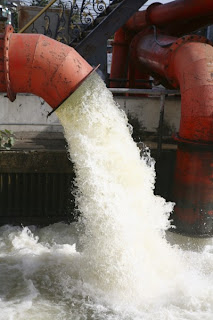Because of the ingenious cross-axis design of the Flipwing, they can also generate power even in flows that are not clean, or even free of effluvia--flows like those found in sewer and wastewater systems in nearly every community.
There are 16,583 wastewater treatment plants in the United States serving nearly 3/4 of the population. There is growing interest in treating wastewater as a resource rather than something simply to be disposed. The biosolids have obvious application as fertilizer. The sludge can potentially be turned in to energy. Sewage can produce methane for fuel. Washington the Budd Inlet Treatment Plant has a pilot program to do just this. Treatment plant sites also lend themselves to solar installations. There are lots of ways to turn this waste into economic value.
As is the case with any site suitable for hydropower, the flow must be natural, moving due to gravity rather than to pumping. Sewage facilities like Seattle's Brightwater would not likely be customers as they would have few, if any, stretches of sufficiently strong and free flow. However, there are many facilities with suitable flows because plants and piping infrastructure are cheaper to operate where gravity can be used and the cost of pumping avoided. Treatment plants are typically sited to to seek this advantage.
Using wastewater flows to make power is a relatively new idea, but not unprecedented:
The first hydroelectric plant in Australia to generate power from treated sewage has been switched on at North Head sewage treatment plant as part of a New South Wales plan to reduce greenhouse gas emissions and generate green energy.It is great to see this happening. This project used a 60-foot drop which not all potential projects would enjoy. A hydrokinetic approach would work is many more flows as long as their was a fast enough flow, 2 m/s or more.
The hydro project was installed as part of a $150 million upgrade to the sewage treatment plant, government reports indicate.
The hydropower plant works by capturing energy from treated wastewater falling down a 60- meter shaft and will generate enough green energy to power almost 1,000 homes for a year, the government reported.
The new hydro plant will reduce Sydney Water’s greenhouse gas emissions by more than 12,000 tons a year, reports indicate.
Three wastewater treatment plants, in Washington, New York and Oregon, have inquired so far about purchase of Hydrovolts turbines.

No comments:
Post a Comment